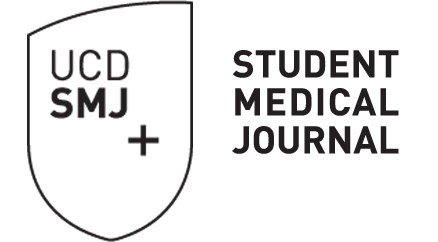Article types
The UCD SMJ accepts articles that fall within the following categories:
Original Student Research
Review Articles
Case Reports
Interviews
Abstracts
Commentary
Research News
Travel Briefs and Elective Experiences
Ethical Discussions
Careers
Patient Perspectives
Artwork
Educational Poster
If you are unsure as to which category your piece falls, please email us. If your piece does not fall into one of the above areas, but is a health-related article, please contact us.
Please note that articles can be rejected without review on the basis of not being formatted correctly or properly referenced.
For a quick guide on how to write these articles please see here. For full details please refer to the Article Specific Guidelines.
Original Student Research
Description: Original clinical, laboratory or other research conducted by students, including SMMS (e.g. SSRA) projects
Word Count: 3000 (plus 250-word abstract)
References: 30
Tables & Figures: 4
Review Articles
Description: Reviews of the literature surrounding important and interesting medical topics. Includes meta-analysis, systematic review, and informal literature review. These aim to provide a clear in-depth update on research and clinical practice advancements. Please consult previous editions and other publications for guidance on structure and content. Reviews conducted as part of coursework are acceptable, however, this should be declared.
Word Count: 3000 (plus 250-word abstract).
References: 30
Tables & Figures: 4
Case Reports
Submissions MUST include a completed Participant Consent Form (see Author Manual).
Description: Articles detailing a single interesting patient case and the case outcome. Please refer to patient as Mr or Mrs X for confidentiality. Also, ensure a patient consent form is filled out. Unique or unusual cases are of particular interest.
Required Sections: Title, Abstract, Case Background, Case Details, Discussion, Conclusions, Acknowledgements, References
Word Count: 2500 (plus 250-word abstract).
References: 15
Tables & Figures: 2
Interviews
Submissions MUST include a completed Participant Consent Form (see Author Manual).
Description: Interviews with past graduates, consultants, interns, colleagues, etc. These types of articles could aim to give a ‘day-in-the-life’ picture of medical specialties, health professionals, or researchers.
Required Sections: Title, Introduction, Body Text, Acknowledgements.
In the introduction, include a profile of the interviewee and a key message of the interview
Word Count: 2000.
References: 2
Abstracts
Description: Concise summary of original student research. Please follow SSRA guidelines (page 15 of the linked document)
Required Sections: Title, Background, Methods, Results, Conclusions, Acknowledgement (if required), References (if required)
Word Count: 300
References: 2
Tables & Figures: 1
Commentary
Description: Can span a wide range of medically related topics and should aim to provide an individual perspective or express an opinion on a medical issue. These articles could report on topical medical issues, policies, conferences, or personal experiences in the field of medicine.
Required Sections: Title, Body Text, Acknowledgements, References
Word Count: 1500
References: 2
Tables & Figures: 2
Research News
Description: Can span a wide range of medically related topics and recent developments in these fields. May include a discussion of this research’s impact on current health policy or medical practice. These articles could report on basic science, translational, surgical, clinical, or public health research.
Required Section: Title, Body Text, Acknowledgements (if applicable), References (if required)
Word Count: 750
References: 10
Tables & Figures: 2
Travel Briefs and Elective Experiences
Description: An opportunity to share your experience from medical related experience abroad. Could include an overseas research, medical elective, or volunteering experience (VO, MSOR, etc). May include discussion of cultural differences experienced, differences in medical practice, personal anecdotes and insights gained. Accompanying photographs are encouraged.
Required Section: Title, Body Text, Acknowledgements (if applicable), References (if required).
Word Count: 600
References: 2
Ethical Discussions
Description: Discuss the role of ethical principles in health care and their implications. Could further discuss ethical decision-making process from your past experiences.
Required Sections: Title, Body Text, Acknowledgements (if applicable), References (if required).
Word Count: 1000
References: 15
Careers
Description: Insight into careers related to the medical field, either of a doctor or those who work in a healthcare related field (e.g. scientific researcher, allied healthcare professional). Could provide commentary on the current state of the field and effects of recent developments on the future of the profession.
Required Section: Title, Body Text, Acknowledgements (if applicable), References (if required).
Word Count: 750
References: 5
Patient Perspectives
Submissions MUST include a completed Participant Consent Form (see Author Manual).
Description: Patient’s perspective on health research and practice (ex. integration of physical and mental health to improve patient outcomes, placing patient-centred care at the core of medical education).
Required Sections: Title, Body Text, Acknowledgements (if applicable), References (if required).
Word Count: 1500
References: Maximum 2
Artwork
Description: Includes photographs, cartoons, digital artwork, drawings and paintings. Should include accompanying description or interpretation. If associated with another article this should be stated and they may be published together.
Required Sections: Title, Description or interpretation, Acknowledgements (optional), References (optional).
Word Count: 50
References: 2
Educational Poster
Description: Poster detailing an educational tool (ie. Coakley medal dissections) created for the continued learning of medical students.
Required Sections: Title, Introduction, Description of educational tool, Future use, References (optional).
Word Count: 1 A4 page. Concise and legible as a poster.
References: 2
